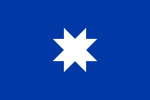
The Guñelve (Mapudungun: Wünelfe / Wüṉyelfe, lit. 'bringer of dawn'), sometimes known as the Star of Arauco, is a symbol from Mapuche iconography which can be described as an octagram (or a star with eight points) in saltire.
It represents the planet Venus, but has also erroneously been thought to represent the canelo tree, which is considered sacred among the Mapuches.[1]
The guñelve was the inspiration of Bernardo O'Higgins to create the current flag of Chile.[2][3][4]
In recent times the guñelve has been used by some designers in Chile, such as during the 2015 Copa América in Chile, when it was used as the symbol of the cup.[5]

YouTube Encyclopedic
-
1/1Views:174 185
-
DIBUJO DE ESTRELLA DE OCHO PUNTAS
Transcription
See also
References
- ^ @jrzv68 (16 June 2013). "Toki kurá: El Otro saqueo al Pueblo Mapuche: El Canelo y La estrella de Arauco. (Aukanaw)".
{{cite web}}: CS1 maint: numeric names: authors list (link) - ^ "La CPU Coja ©2018 » Símbolos: La Bandera".
- ^ Guaquil, Rodolfo Manzo. Los verdaderos emblemas de la República de Chile: 1810-2010 (in Spanish). p. 23.
Otro aspecto importante en la bandera es la estrella de cinco puntas e inclinada que representa a la wünelfe, nombre que con que los indígenas mapuches asignaban al planeta Venus...
- ^ Amunátegui Aldunate, Miguel Luis (1870). Los precursores de la independencia de Chile (in Spanish). Vol. III. Santiago, Chile: Imprenta, Litografía i Encuadernación Barcelona. pp. 587–590. Retrieved 11 October 2019.
- ^ "Los simbolismos detrás del logo de la Copa América". BolaVip.

